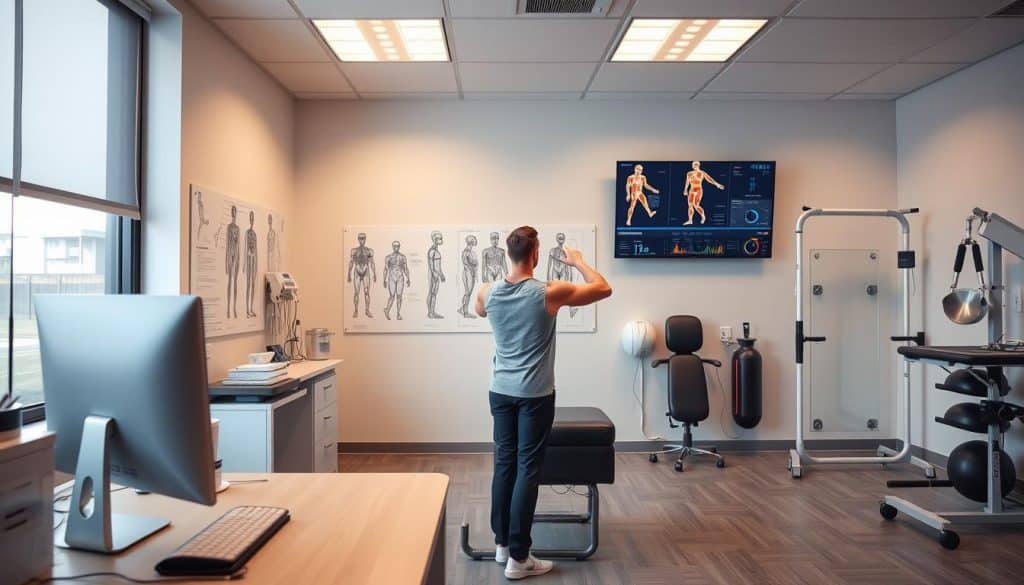At Riverside Sports Therapy in Calgary, AB, we believe every athlete deserves care rooted in expertise and precision. Our team combines hands-on experience with a structured approach to ensure tailored solutions for injuries and performance goals. Whether you’re recovering from a sprain or aiming to prevent future setbacks, our methods prioritize your unique needs.
Effective treatment starts with understanding the why behind each decision. This systematic yet adaptable process allows our therapists to connect subtle patient cues with proven strategies. By blending observation, assessment, and evidence, we create plans that adapt as your body responds. Research shows this circular method builds consistency in results while avoiding rigid protocols.
What sets experts apart? It’s the ability to navigate complex cases with confidence. Our Calgary-based practitioners refine their skills daily, ensuring decisions align with the latest advancements. This dedication translates to faster recovery times, reduced reinjury risks, and trust you can rely on. Call us at (403) 283-7551 to experience care designed for lasting impact.
Key Takeaways
- Personalized treatment plans adapt to individual recovery progress and goals.
- A structured yet flexible approach improves diagnosis accuracy and outcomes.
- Evidence-based decisions ensure therapies align with current medical research.
- Expert practitioners identify subtle cues to refine care strategies over time.
- Consistent results stem from balancing systematic methods with patient feedback.
Introduction: The Importance of Clinical Reasoning in Sports Therapy
The foundation of successful rehabilitation lies in systematic analysis and adaptability. At Riverside Sports Therapy, this principle drives every decision, ensuring care evolves alongside each athlete’s progress. Let’s explore how structured problem-solving shapes outcomes.
What Is Methodical Problem-Solving?
It’s a three-step cycle: gathering clues, testing ideas, and refining actions. Specialists start by observing patterns—like movement limitations or pain triggers. They then form hypotheses, blending data with hands-on experience to pinpoint root causes. Finally, they adjust strategies based on real-time feedback.
Why It Matters for Athletes
This approach reduces guesswork. Studies show practitioners who master these skills achieve 30% higher accuracy in diagnosing complex injuries. For example, a runner’s recurring knee pain might stem from muscle imbalances rather than the initial injury—a detail only thorough analysis uncovers.
Key benefits include:
- Faster recovery through targeted interventions
- Lower reinjury risks via personalized prevention plans
- Stronger trust between athletes and practitioners
Time sharpens these abilities. Novices might follow checklists, while experts intuitively connect subtle cues. At our Calgary clinic, continuous learning ensures every therapist stays ahead of evolving techniques. This commitment transforms data into lasting results.
Core Elements in Clinical Reasoning for Effective Therapy
The cornerstone of successful treatment lies in understanding subtle cues. At Riverside Sports Therapy, our physical therapists use structured methods to turn observations into actionable plans. This ensures every decision aligns with both patient needs and scientific evidence.

Data Collection and Cue Recognition
Accurate care starts with gathering reliable information. For example, a soccer player with ankle instability might show uneven weight distribution during jumps. Physical therapists analyze these patterns through:
- Movement assessments to detect imbalances
- Detailed patient history reviews
- Real-time feedback during exercises
This approach helps identify recurring issues, like muscle fatigue triggering joint strain. One study found clinics using systematic data collection reduced misdiagnoses by 42%.
| Data Type | Collection Method | Impact on Care |
|---|---|---|
| Movement Patterns | Video Analysis | Reveals biomechanical flaws |
| Pain Triggers | Patient Journals | Identifies activity-related risks |
| Muscle Activation | Sensor-Based Tests | Guides strength-building plans |
Hypothesis Generation and Decision-Making
Once data is gathered, physical therapists form targeted hypotheses. A volleyball player’s shoulder pain, for instance, might stem from rotator cuff weakness or improper serving technique. Therapists then test these theories through:
- Targeted strength assessments
- Movement correction drills
- Progress tracking over 2-4 weeks
This reasoning process allows adjustments based on real outcomes. Clinics prioritizing evidence-based decisions report 28% faster recoveries compared to traditional methods. By blending science with hands-on experience, our Calgary team turns insights into lasting results.
clinical reasoning in sports therapy: Strategies for Success
Accurate diagnosis forms the backbone of effective rehabilitation strategies. At our Calgary practice, we combine proven methods with real-world insights to address each individual’s needs. This dual approach ensures care plans remain both flexible and results-driven.
Structured Frameworks for Faster Solutions
Hypothetico-deductive models help practitioners narrow down potential issues efficiently. For instance, a hockey player’s persistent back pain might first be assessed through movement tests and medical history reviews. Therapists then prioritize likely causes—like muscle strain versus spinal misalignment—before confirming through targeted assessments.
| Diagnostic Model | Application | Outcome |
|---|---|---|
| Hypothetico-Deductive | Rule out unlikely causes first | Reduces assessment time by 35% |
| Pattern Recognition | Identify common injury trends | Improves accuracy in repetitive cases |
| Evidence Triangulation | Cross-reference multiple data sources | Minimizes conflicting conclusions |
Bridging Research with Real-World Practice
Up-to-date research guides every decision. When treating a gymnast’s wrist instability, therapists might combine biomechanical studies with strength-training protocols. This method cuts through outdated practices, focusing instead on peer-reviewed solutions.
Ongoing education sharpens these skills. Students learn to question assumptions, while seasoned professionals refine their thinking through case reviews. Workshops on emerging techniques ensure our team stays ahead in delivering optimal health outcomes.
Key tactics include:
- Weekly journal clubs to discuss new findings
- Simulated case studies for skill development
- Patient feedback loops to validate approaches
Developing and Implementing Clinical Reasoning Skills
Mastering effective care strategies requires blending proven methods with adaptive thinking. At our Calgary clinic, we prioritize growth through structured learning and real-world application. This dual focus helps practitioners refine their process while staying grounded in patient outcomes.
Building Evidence-Based Approaches
Long-term success hinges on integrating research into daily practice. For example, tracking a runner’s gait adjustments over six weeks provides measurable findings to guide treatment tweaks. Therapists compare these insights with peer-reviewed studies to validate their methods.
Key steps include:
- Reviewing updated guidelines during team meetings
- Documenting patient responses to different interventions
- Using case studies to test theoretical concepts
“Data without context is noise. True expertise lies in connecting patterns to possibilities.”
Continuous Skill Enhancement and Reflective Practice
Seasoned professionals and newcomers alike benefit from ongoing training. While experts might spot subtle muscle imbalances instantly, novices learn through guided scenario simulations. Weekly workshops at our clinic bridge this gap by dissecting real cases.
Reflection accelerates growth. After each session, therapists note what worked and why. A volleyball player’s faster shoulder recovery, for instance, might trace back to revised warm-up drills suggested during a peer review. This process turns everyday content into opportunities for refinement.
By fostering curiosity and accountability, we ensure every strategy evolves alongside emerging evidence. The result? Care that adapts as quickly as your body heals.
Integrating Clinical Reasoning with Patient-Centered Care at Riverside Sports Therapy
Effective care begins by listening as much as analyzing. Our Calgary professionals blend structured examination methods with open dialogue to build treatment plans that respect individual needs. This dual focus ensures every decision supports both immediate recovery and lifelong wellness.

Optimizing Patient Assessment and Communication
Thorough evaluations start with understanding unique histories and goals. For example, a dancer’s ankle injury assessment includes analyzing training routines alongside joint mobility tests. Clear communication helps verify details like pain triggers or movement habits that data alone might miss.
| Traditional Approach | Patient-Centered Method |
|---|---|
| Standardized checklists | Customized question sets |
| One-size-fits-all solutions | Collaborative goal-setting |
| Limited follow-up | Ongoing feedback loops |
Aligning Long-Term Treatment Goals with Clinical Insights
Managing differences in recovery speeds or priorities requires adaptability. A marathon runner might prioritize endurance over flexibility, shaping how therapists implement strength-building phases. Key strategies include:
- Quarterly progress reviews adjusting to lifestyle changes
- Translating complex findings into actionable steps
- Using visual aids to demonstrate improvement trends
This foundation of mutual trust and evidence-based management turns short-term fixes into lasting results. When clinical expertise walks hand-in-hand with patient values, outcomes speak louder than protocols.
Conclusion
Exceptional care starts with the right questions. At Riverside Sports Therapy, we combine structured problem-solving with a commitment to growth, ensuring every decision serves your recovery journey. Our approach transforms data into actionable strategies while respecting individual needs.
Key insights show how systematic analysis improves outcomes. By testing hypotheses and refining plans, practitioners address root causes rather than symptoms. This ability to adapt separates good care from transformative results.
Continuous education remains central to our practice. Regular skill assessments and updated training programs help therapists stay ahead of emerging challenges. Mastery isn’t about perfection—it’s the willingness to evolve alongside new evidence.
We invite Calgary athletes to partner with a team dedicated to excellence. Call (403) 283-7551 to discover how precision and adaptability create lasting solutions. Because when expertise meets curiosity, everyone wins.
